INDIAN ARMED FORCES CHIEFS ON OUR RELENTLESS AND FOCUSED PUBLISHING EFFORTS

The insightful articles, inspiring narrations and analytical perspectives presented by the Editorial Team, establish an alluring connect with the reader. My compliments and best wishes to SP Guide Publications.

"Over the past 60 years, the growth of SP Guide Publications has mirrored the rising stature of Indian Navy. Its well-researched and informative magazines on Defence and Aerospace sector have served to shape an educated opinion of our military personnel, policy makers and the public alike. I wish SP's Publication team continued success, fair winds and following seas in all future endeavour!"

Since, its inception in 1964, SP Guide Publications has consistently demonstrated commitment to high-quality journalism in the aerospace and defence sectors, earning a well-deserved reputation as Asia's largest media house in this domain. I wish SP Guide Publications continued success in its pursuit of excellence.
- Indian Air Force Aims for Full Indigenous Inventory by 2047 — Air Chief Marshal A.P. Singh
- Rajnath Singh assumes charge as Defence Minister for the second consecutive term
- Interim Defence Budget 2024-25 — An Analysis
- Union Defence budget 2024
- Prime Minister Modi Flies in the LCA Tejas
- New Chapter in India-Italy Defence Ties
- Airpower beyond Boundaries
Dare to Dream, Disrupt and Innovate in Defence Sector – Rajnath Singh at DRDO's Defence Technology Acceleration
Defence Minister Rajnath Singh put his thrust on R&D in the military at the Industry Workshop on Defence Technology Acceleration organised at DRDO. He called for breaking boundaries and the need to achieve advancements in both incremental and disruptive tech through the latest innovations, leading to discussion on critical and emerging tech.
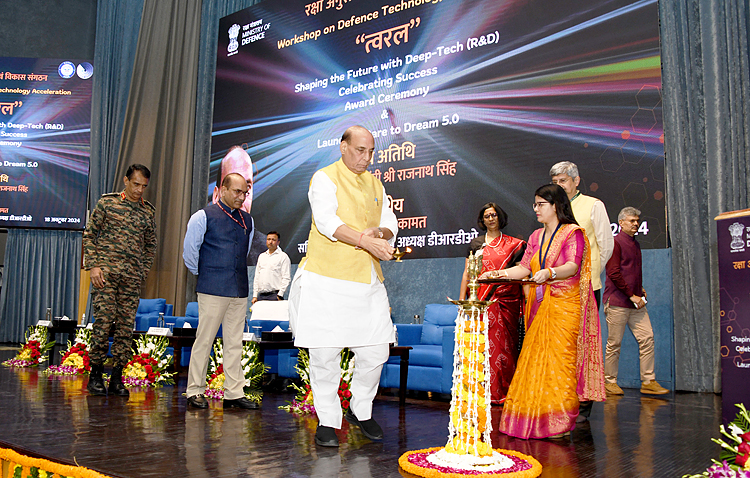
New warfare technologies have introduced an element of urgency to observe and act on a new approach to the capability development roadmap. That is about the national thrust on R&D in military technologies. The military needs to sharpen its readiness in advanced technology, emerging technology, nuclear, cyber, space, and artificial intelligence.
Defence Minister Rajnath Singh has called upon the private sector to move forward from 'participation' to 'taking lead' in the defence sector, assuring the Government's full support to make India an innovation & technology hub and one of the strongest countries in the world.
Defence Minister Rajnath Singh has urged the private sector to move from mere participation to taking the lead in the defence sector, assuring full government support to make India an innovation and technology hub.
He was addressing scientists, industry leaders, academia, start-ups, MSMEs and young entrepreneurs during Twaral, a DRDO-Industry Workshop on Defence Technology Acceleration organised at DRDO Bhawan in New Delhi on October 18.
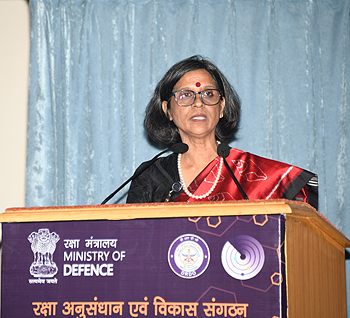
The Defence Minister also launched 'Dare to Dream 5.0' for innovators to come forward with transformative ideas for defence applications under the Technology Development Fund (TDF). Deep-Tech challenges unveiled to drive major advancements in areas critical to defence infrastructure. "Need to achieve advancements in both incremental and disruptive tech through out-of-the-box thinking & latest innovations" he said. Cutting-edge indigenous technologies developed under the TDF scheme were handed over to users.
"TDF is a revolutionary and unique scheme. It provides grants to the private sector. We sign agreements, give test facilities, handhold them, and provide complete support to the private sector, focusing on indigenising, explained Nidhi Bansal, Director, TDF.
Two in-depth panel discussions were held which were led by Manish Kumar Jha, Defence Editor and National Security Analyst. The first, on Critical and Emerging Tech Collaboration, explored the potential for international R&D partnerships and the sharing of Intellectual Property in military technology. The second discussion addressed the theme of self-reliance in defence technology and manufacturing, focusing on the need for innovation and strong R&D to build a sustainable and robust domestic ecosystem.
Twaral: A National Mission R&D in Military Tech
How much the government prioritise its thrust on R&D in the military was visible when Defence Minister Rajnath Singh came and spoke passionately, along with the country policymakers and top military commanders, gathered at one place to deliberate such policy direction.
On critical technology and self-reliance, the national discourse took place with the entire leadership present for the technology acceleration, including, Sanjeev Kumar, Defence Secretary (DP); S.V. Kamat, Chairman and Secretary DDR&D and DRDO; Lt General Johnson P. Mathew, the Chief of Integrated Defence Staff (CISC); Lt General N. S. Raja Subramani, Vice Chief of the Army Staff; Vice Chief of Air Staff Air Marshal Sujeet Pushpakar Dharkar; and Vice Chief of the Naval Staff Vice Admiral Krishna Swaminathan.
The launch of 'Dare to Dream 5.0' aims to encourage innovators and start-ups to present transformative ideas for defence applications under the Technology Development Fund (TDF), providing up to 90 per cent grant support for eligible projects.
The talk on the criticality of warfare and the absorption of technology remains fundamental to military capability and doctrinal direction. The question is not about having the capability plan but a plan which is built around the shifting dimensions of warfare. The current global in a complex hybrid format–Russia-Ukraine and Israel-Palestine- Iran-- indicates the massive direction in how the new tech is shaping the battle in terms of attack and counter-attack.
The discussion around the first key panel centred on such a complex theme addressing "Critical & Emerging Tech Collaboration – Scope of R&D collaboration, IPs for Military Tech with international agencies."
The first panel discussion focused on key challenges and roadmap with distinguished military leaders, Deputy Chief of Army Staff (IS&C) Lt General Rakesh Kapoor and Deputy Chief of Air Staff Air Marshal Tejinder Singh, S.K. Jha, CMD, MIDHANI; Nidhi Bansal, Director, DTDF; Dr H.B. Srivastava, Professor, IIT Delhi and leading the crucial industry, Ashish Kansal, CEO, SMPP.
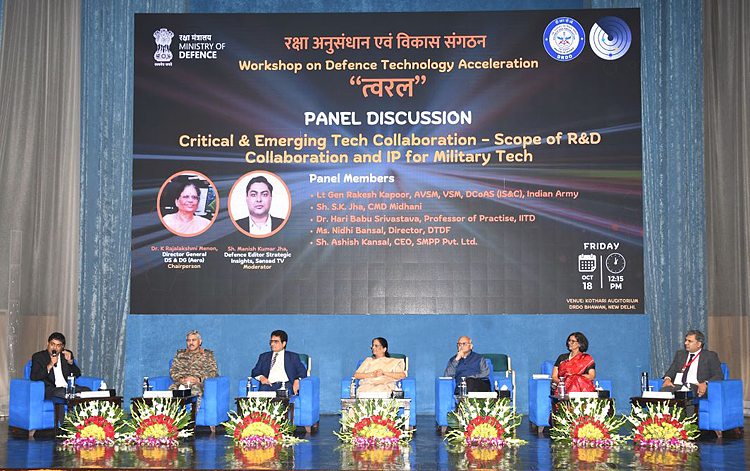
The tech trust in aerospace is the reflection of the emerging hybrid conflict and how India is embarking on an ambitious mission in aerospace on multiple fronts, said Manish Kumar Jha, opening the ground for deliberation with the Chair, K. Rajalakshmi Menon, DG (Aero) at DRDO.
DRDO has opened the door across the military technology perspectives from Arjun tank to Tejas, Akash and Prithivi missiles to leaping into hypersonic and breaking into the super complex aircraft carrier INS Vikrant and nuclear and atomic assets. However, we must leapfrog on critical technologies like propulsion systems, jet engines, materials, and emerging autonomous systems.
What is the roadmap? How can we be the front-runner in innovating and absorbing such advanced tech? Also, let's address some of the key elements in our quest for developing such advanced tech--Testing and Certification for critical technologies–limited resources for defence companies in India.
During the DRDO-Industry Workshop 'Twaral,' key discussions highlighted the importance of R&D collaboration in critical and emerging technologies, with a focus on self-reliance in defence manufacturing.
As Defence Minister Rajnath Singh pointed out in sharing insights on the transformation of the defence sector in the recent past, today, technology has transformed conventional warfare into unconventional warfare. "New dimensions have been added to modern-day warfare such as drones, cyber warfare, bio-weapons and space defence. In this transformative phase, R&D in defence will make the defence sector stronger.
"It is heartening to witness our scientists, industrialists, academia, startups, MSMEs and young entrepreneurs working together in this endeavour. It is time for the private sector to take the lead as it has the ability to absorb rapid changes and create innovations," he said.
Rajnath Singh termed the adoption of unconventional ideas, not yet known to the world, as the only way to progress in unconventional warfare. Acknowledging it as a tough task, he stated that the Government, led by Prime Minister Narendra Modi, will continue providing all necessary support to the youth, scientists, industrialists and MSMEs in this endeavour.
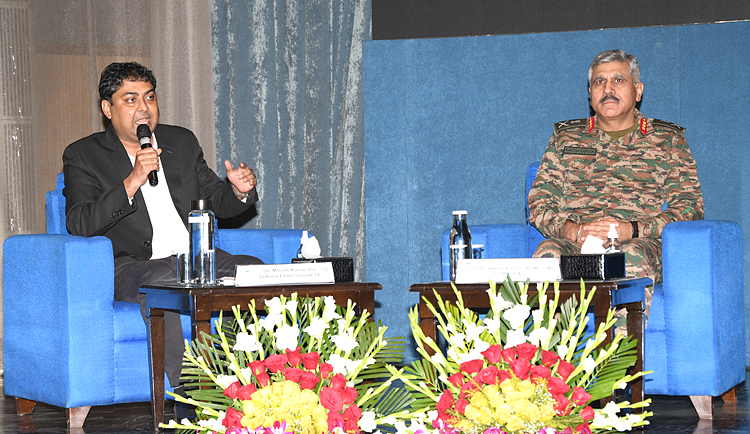
Rajnath Singh reiterated the Government's commitment to making the defence sector more innovative and technology-oriented. Highlighting the consistent efforts being made by DRDO to strengthen the R&D environment and promote the scientific temperament, he said: "Technology Development Fund (TDF) scheme is providing up to 90 per cent of the total project cost as grant support to eligible industries. The total support is up to Rs 50 crore, a good amount for any MSME and start-up to invest in defence R&D. Since its launch six years ago, 79 projects have been sanctioned, of which, technology has successfully been developed in 18 projects."
The Amended Standard Operating Procedures for TDF, aimed at simplifying the process for start-ups and MSMEs to collaborate with DRDO, was also released. These updated procedures are designed to foster a more transparent and streamlined approach for innovators, enabling easier access to opportunities for contributing to national defence projects.
Dare to Dream and Innovate in defence
As part of the event, Rajnath Singh launched 'Dare to Dream 5.0' to encourage the next generation of innovators & startups to come forward with transformative ideas for defence applications. The fifth edition of DRDO's innovation contest aims to generate cutting-edge solutions for India to progress further in its pursuit to achieve 'Atmanirbharta' in defence technologies. He also felicitated the winners of 'Dare to Dream 4.0', recognising individual innovators, startups and MSMEs for disruptive solutions and innovations in the fields of countermeasures for drones and swarm of drones; advanced acoustic systems to locate gunfire, directed energy technologies, cognitive listening device, target seeking & proximity sensing, free-space laser communication system, multi-terrain multi-utility robot among others.
Defence Minister emphasised the need to achieve advancements in both incremental and disruptive technologies within the defence sector.
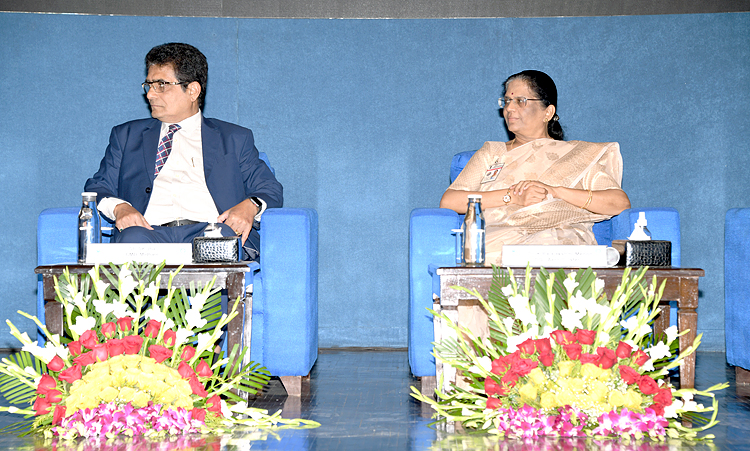
As initiated under the TDF, the solutions to challenges obtained through initiatives such as 'Dare to Dream' bridge the critical gap between the two types of technologies, he said. He called upon scientists, startups & young entrepreneurs to think out of the box and come out with the latest innovations as if it were their habit to accept & overcome challenges.
Rajnath Singh exhorted the private sector to move in line with the unprecedented speed with which the technological changes are taking place across the globe. He urged them to ensure, through timely assessment, that technology does not become outdated when it is rolled out. He also called for the development of projects, under TDF, based on cutting edge tech, and devising a system of comprehensive scan within the scheme to avoid duplication of technologies.
Deep-Tech Challenges
The crucial discussion on "Critical & Emerging Tech Collaboration – Scope of R&D collaboration, IPs for Military Tech with International Agencies" opened many frontiers to address and deliberate the challenges.
The fundamentals of emerging tech do thrive on the efforts which are based on the culture of R&D built around the cohesive ecosystems of R&D institutes, Industry and academia with their ideas and laboratories breaking new ground.
As Rajnath Singh outlined, "We should not re-invent the wheel but break new technologies and innovation for indigenous systems and platforms."
That is about the niche technologies and how the services, especially the army which is the largest force in the world, look at technology infusion. As Lt General Rakesh Kapoor, DCOAS (IS&C) explained, the technology infusion is certainly based on the lessons that the Indian Army (IA) has drawn from the current global conflicts and that does reflect the way the IA approaches the issue of Technology Infusion in its systems and doctrines.
Defence Minister Rajnath Singh emphasised the need for advancements in both incremental and disruptive technologies to strengthen the defence sector, citing the importance of out-of-the-box thinking and innovation.
"The years 2024-25 are marked for such critical and emerging technology," Lt General Kapoor said.
The scope of R&D is now to push boundaries further from here, build jet engines, and 6-Gen Advanced Medium Combat Aircraft (AMCA), advanced materials, and build MALE/HALE autonomous aircraft/drones and next-generation nuclear submarines in India.
The Indigenous effort for the critical technology must also open to greater collaboration. The technology assimilation is also based on collaboration as science and tech need no boundaries so embrace, collaborate, and scout out the best of the class of the technology worldwide with our friends and partners, said Manish Jha.
The emergence of IP is a critical factor and we all work towards addressing the challenges for the industry and R&D bodies, said Nidhi Bansal, as she is geared to drive innovation within integrating the DRDO with the defence industry and emerging and innovative startups in India.
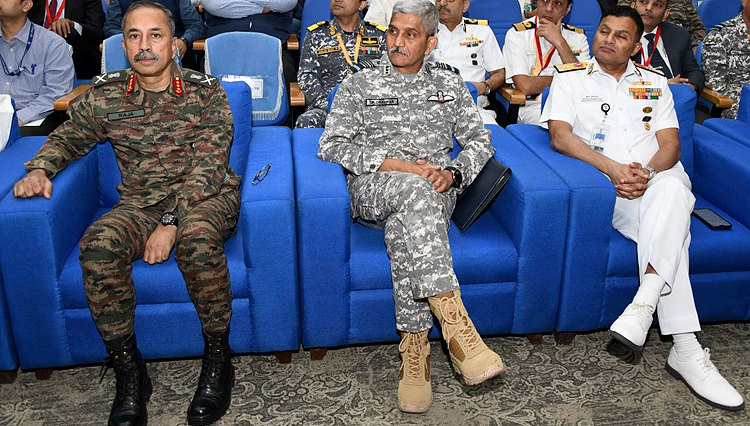
The recent development of "Fuel System Temperature Transducer for Aircraft Application" by Tejase Aerosense for ADA took place under the TDF scheme and is one of the prime examples of emerging startups for new tech. Another, Simulator for Unmanned Ground, Marine (Sea Surface and Underwater) and Aerial Vehicles by Combat Robotics India promises the potential to lead in unmanned areas. Further, Autonomous Drone as first responders for search and report missions in enclosed/indoor environments developed by NewSpace Research and Technology is the outcome of such initiatives. Both were handed over to the users with robust testing parameters set out by DRDO.
"We will see breakthroughs across the mil-tech domain", said Nidhi Bansal, on the initiative under Dare to Dream.
Several challenges on Disruptive, Emerging, Enabling and Pioneering Technologies (Deep-Tech) were also launched to drive major advancements in areas critical to the country's defence infrastructure.
Crucially, the discussion brought up the key elements of critical technology, the materials or advanced materials. Material is critical to many systems, infrastructure, and platforms, which the military uses. We talk about TEJAS and the futuristic Advanced Medium Combat Aircraft (AMCA) or land systems, industrial innovations are taking greater shapes, remarked S.K. Jha, CMD, MIDHANI. He said the materials are being used towards the 'Make in India' effort in areas such as critical components of the engine using complex material, armoured vehicles and next-generation materials for military platforms and systems.
Advancements in materials have achieved significant milestones in areas such as armoured protection as highlighted by Ashish Kansal, CEO, SMPP. We are a globally competitive entity with best-in-class armoured protection and technology, the reason for not only servicing the Indian Armed Forces but globally, Kansal adds.
"Material is the core. Boron Carbide is used in armour application. Only the US has this tech. Nobody has access. We did in-house research. Our tech is better than theirs," Kansal emphasises as he points out a significant percentage of revenue that he put into R&D.
R&D must remain the most fundamental and priority. SMPP is a home-grown private defence entity geared towards advanced technologies with a greater thrust on R&D and innovation. In fact, the government has especially marked its sizeable budget, especially for the private sector. As defence minister re-emphasised in his speech, "Government to provide full support to the private sector in taking the lead in the field of defence & making India an innovation & technology hub."
However, the debate on the R&D thrust is incomplete without academia. Do we need greater efforts for academia to gear towards the applied side of R&D? Certainly, academia could do much better, especially in military technology as clearly explained by H.B. Srivastava, Professor, IIT Delhi.
"Military technology is rapidly changing and bringing cutting-edge solutions to the armed forces. Where does Academia stand in terms of achieving such goals?
Manish Kumar Jha is a Consulting & Contributing Editor for SP's Aviation, SP's Land Forces and SP's Naval Forces and a security expert. He writes on national security, military technology, strategic affairs & policies.





